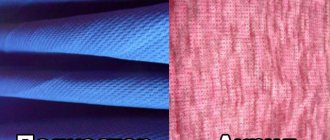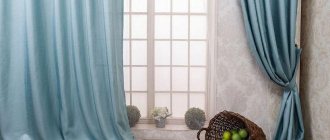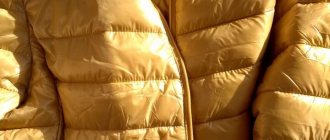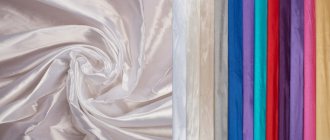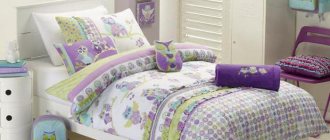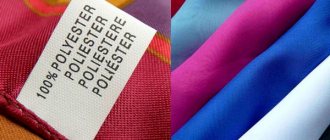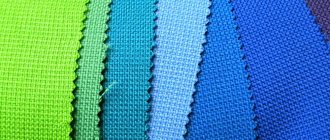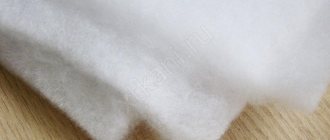Polyester items
Polyester is a man-made fiber that is most often used in the manufacture of outerwear, travel bags, military uniforms and many other things.
In order for polyester to acquire shine, various additives are used in the composition. Polyester products are distinguished by:
- easy care of the product;
- resistance to fading in the sun;
- preservation of the original shape of the product;
- quick recovery after getting wet.
The disadvantage of polyester compared to nylon is its low hygroscopicity. Polyester also weighs significantly more than nylon when comparing pieces of the same size.
This fabric has such disadvantages as:
- material rigidity;
- polyester is highly electrified;
- may cause allergies;
- with careless care it quickly loses its appearance;
- airtightness.
Considering all the shortcomings, we can conclude that for the summer season you need to buy things made of nylon.
Nylon products
Nylon has useful, practical qualities such as wear resistance, elasticity, and lightness.
Nylon products are easy to care for, they are easy to wash, and do not need to be ironed. After washing, things dry instantly and look fresh for a long time.
Nylon has been made from polyamide for several decades. Over the years, it has earned popularity among consumers from all walks of life. Many things are sewn from nylon such as:
- tights;
- stockings;
- swimwear;
- women's and men's underwear;
- blouses, dresses;
- shirts, trousers;
- suits, raincoats.
Nylon is often added to fabrics used for making clothes. In its pure form, nylon has a lot of stretch and is not always suitable for certain types of products.
Nylon is softer and lighter compared to polyester. This does not prevent it from having enhanced resistance to damage and wear. The positive properties of nylon include:
- moisture resistance;
- resistance to deformation;
- elasticity.
The disadvantages of nylon include “fear of ultraviolet radiation”.
In essence, both nylon and polyester are easy-to-use, durable and comfortable fabrics to wear. Which material is better depends on what kind of item is made from them.
Navigation within posts
- Polyester blanket
- Transparent polyester film
What can a clothing label tell you?
Sometimes housewives find themselves confused when they see a tag on their clothes; a lot of badges and foreign letters confuse them. In fact, the symbols are intended to help the consumer and give him the most accurate information about the product and how to properly care for the fabric so that it serves for many years.
I sincerely want to help the reader understand the labeling of goods and answer questions of interest. What can the designations on clothing labels tell us:
- Manufacturer of the product.
- The country where the item was made.
- Operational point: recommendations regarding washing, ironing, bleaching and drying.
- Size.
- What fabric is the item made from, percentage composition of fibers.
I suggest first understanding the icons. A crossed out circle, a bowl of water, an iron, what does it all mean and how to remember everything? In fact, there are not many symbols, only about 30. This is an international marking, so it doesn’t matter whether the clothes are imported or domestic - the symbols will be the same everywhere, it won’t be difficult to read them and remember them. There are only six operations for caring for things:
- Washing – indicated by an icon depicting a bowl of water.
- Whitening – a triangle with an icon inside.
- Chemical cleaning - circle with Latin letters. This icon is for dry cleaning workers; it informs about what professional products are best to use to clean this item.
- Ironing is symbolized by an iron, with several dots - this is a graphic representation of the temperature at which this type of fabric can be ironed.
- A circle in a square means drying in an automatic machine.
- A square icon with stripes inside tells you how to dry the product.
There may be one or two lines under the main icon, or there may not be any at all. One line means that the product requires gentle treatment, and two lines warn that only delicate washing, drying, etc. is suitable. If there are no lines, then the fabric is strong enough to be washed on a medium or maximum cycle. Let's look at each icon individually.
Features of nylon
Nylon was originally meant to be a cheap alternative to fabrics such as natural silk. Nylon wears and feels very similar to it.
The main characteristics of the material are as follows:
- Nylon or polyester? – What is the difference between them and which is better?
- nylon is a fairly lightweight, but at the same time extremely durable material that can definitely be classified as resistant to various damages;
- this fabric washes well, there are no streaks left on it, it dries quickly enough, and you don’t need to put a lot of effort into ironing it;
- the fiber of the fabric is smooth, it feels pleasant to the touch, and looks attractive - because of these qualities, manufacturers often add nylon to other fabrics;
- nylon repels moisture, it can be classified as waterproof.
But with these advantages there are also disadvantages:
- this fabric does not like being exposed to ultraviolet radiation; it will fade quite quickly if it is exposed to the sun for a long time;
- nylon can become electrified, which can cause discomfort when wearing;
- does not allow air to pass through well.
Let's move on to the next fabric.
I. Main characteristics of carpet
When choosing carpet, you should pay attention to the following key parameters:
- Density (usually from 680 to 950 gsm), which depends on the caliber of the production machines, the thickness of the yarn and the number of stitches per unit area. In rooms where there is a lot of foot traffic, you need to lay the product with a high density; low-density carpet is suitable for rooms with little traffic;
- The weight of the carpet is also related to the density characteristic. The higher it is, the more stable the product;
- The manufacturer's "texture retention" guarantee is the property of carpet to return to its original shape after being walked on. The warranty should preferably be at least 10 years;
- Antistatic properties. Due to the friction that occurs when walking, an electrical charge arises on carpeting (especially wool). Therefore, modern products add components of modified carbon, which minimizes static, or use special antistatic agents;
- Wear resistance class - can have values from 21 to 43.
- Sound insulation – from 15 to 29 dB and thermal conductivity – approximately 0.05 W/(m*K).
- Pile and/or loop height;
- The color and texture of the carpet, which affect the overall appearance of the room.
III. Material of manufacture: pros and cons
Depending on the material of the thread used in production, the following types of carpet are distinguished:
- natural;
- mixed;
- artificial.
Natural carpet
Natural carpet is usually made from wool, but linen, cotton or jute are sometimes used. Woolen products are characterized by elasticity and elasticity of the pile, low thermal conductivity, and poor flammability. However, they are very expensive when compared to artificial carpet. They have low wear resistance (class 21), are easily soiled, and are also susceptible to mold and moths. These negative qualities are reduced by additional treatment of wool with dirt-repellent, anti-moth and other substances. There is another significant disadvantage of wool carpet - the product is not suitable for housing people who are prone to allergies.
Mixed materials
Thanks to the combination of wool yarn (about 80%) and artificial fibers (about 20%), the wear resistance of the carpet increases and the advantages of natural covering are preserved.
Artificial carpet
The main synthetic fibers used in the manufacture of carpet are polyamide (nylon), olefin (polypropylene), polyester and polyacrylic. The advantages of synthetic carpet include:
- high homogeneity;
- natural moth resistance;
- good tensile and fracture resistance;
- resistance to loads.
The highest quality material is nylon, it is soft, holds lint well, is easy to clean and lasts a long time (10-15 years). Polyester is cheaper than its nylon counterpart, but it is less durable. Olefin (polypropylene) has good aesthetic qualities and can be used outdoors, as it is almost unaffected by moisture and ultraviolet radiation. Often used to make commercial carpet, which is glued to a rubberized backing. A negative feature of olefin is its high fragility. Poriacryl wears out quickly, so it is usually used as an additive to other fibers.
Recommendations for selection
So what should you choose - nylon or polyester? Both fabrics are durable, do not deform and can last for many years . They do not allow moisture and air to pass through well, so they are an ideal material for sewing jackets and raincoats, but for the same reason they are absolutely not suitable for making summer clothes.
Since polyester slightly allows water to pass through, it is better to choose demi-season jackets and raincoats made from nylon. Polyester should be preferred when buying summer windbreakers and swimsuits - the fabric will not fade in the sun and will allow the body to “breathe” a little. When purchasing a bag or backpack, it is important to consider the weight of the finished product - accessories made of nylon will be lighter than trunks made of polyester fiber.
The quality characteristics of materials are not always decisive. Products made of nylon or polyester can last 10-15 years , but they will lose their relevance and will require replacement much earlier, because after 3-5 years you will want to buy a new ski suit, bag, curtains for the living room or a fashionable blouse.
ProductsComment
IV. Pile and loop carpet
Pile carpet can be short-pile (pile length from 2 to 3 mm), medium-pile (5-8 mm) and high-pile (from 8 to 20 mm or more). Thanks to the long fibers, the design becomes voluminous in high-pile products. This type of carpet cannot withstand significant loads, so it is best to install it in bedrooms and children's rooms. Short pile options are better suited for high traffic areas. Depending on the weaving method, there are the following types of carpet:
- Velor is a carpet with short cut pile. Can be hard or soft. Wear resistance class - from 23 to 31. The upper part of the fibers of the product fluffs up, so the surface becomes uniform and soft when touched. The advantages of velor carpet include ease of maintenance. However, dirt and shoe marks stand out on a uniform surface. This type of pile is best suited for a bedroom, children's room or living room;
- Saxony (saxoni) is a grainy covering made from twisted yarn. Belongs to the most elite carpet products. Wear resistance class – up to 31. A good choice for halls and hallways. A special type of sexoni is shag, made from coarse fibers 3-4 cm high;
- Cut-loop is a type of carpet characterized by an interesting combination of low loops and long cut threads. Wear resistance class - from 23 to 25. Is a good choice for the bedroom;
- Scroll is a multi-level loop pile formed by a combination of uncut and sheared loops. In addition to the loops, there are single fibers on the surface that add elegance to the product. Scroll has good wear resistance (21-34), usually used in living rooms and corridors;
- Frieze is a carpet with a high and curled pile, giving the product a curly appearance. Wear resistance class - up to 31. Available in various variations: with cut pile, with fibers of various thicknesses, as well as loop pile, which is highly resistant to crushing. Footprints and dirt on this carpet are almost invisible, so it is well suited for living rooms;
- Print is a low-pile covering widely used in children's rooms. This type of coating allows you to apply beautiful non-standard designs.
Various types of carpet can be purchased in departments of the Raduga Home Furnishings Hypermarket. Come to us and our specialists will help you make the right choice.
Polyester
Initially, threads obtained from petroleum-containing raw materials were used to make ropes, cables, packaging bags and packages. Now polyester is used to produce underwear, home textiles, upholstery fabrics, sportswear, outerwear, casual and dressy clothing. Fluffed polyester fibers are used as filler in blankets, pillows and soft toys.
Polyester
Artificial material has undoubted positive properties:
- Does not fade or crumble under the influence of sunlight.
- Doesn't wrinkle.
- Has high strength and wear resistance.
- It is easy to care for.
- When stored and used in places of high humidity, it is resistant to bacteria, fungi and mold.
Polyester has disadvantages that are traditional for many artificial fabrics:
- Rigidity.
- Low breathability.
- Release of harmful substances that can cause irritation and allergies to the skin.
- Rapid loss of attractiveness with improper care.
Like any synthetic fabric, polyester can accumulate static electricity, “stick” to the body and spark. But this drawback is easily eliminated with the help of antistatic agents - aerosols, conditioners and rinses.
Why do you need a vestibule?
Before moving directly to the description of the important characteristics, let's figure out why a tourist needs a vestibule in a tent? At a minimum, three main reasons can be deduced:
- A place where you can sit out a bad hike;
- A place where you can put all additional equipment, equipment, shoes;
- A place to set up a kitchen or even a dining room in bad or windy weather.
The advantages of a vestibule are obvious and it will indeed create additional comfort from traveling, but, as you know, you have to pay for everything, and in this case the payment is weight. A tourist tent with a vestibule will be 20-30% heavier than the same analogue, but without it.
Now we are talking about trekking tourist tents, for which weight is important, because the tourist has to carry everything on his shoulders. Camping tents, by and large, all have vestibules, and here the choice is more about the type of construction, awning material, etc.
Which tent with a vestibule to choose from the whole variety of tourist models?
In simple words - those that you can carry on a hike in your backpack and others that need to be carried by car or similar vehicle.
The word “tourist” is generic for such equipment and it would be incorrect to call it tents only for hiking. Still, any outing into nature, be it by car, motorcycle or bicycle, can also be called a tourist trip or a hike. Therefore, I propose to call hiking trips trekking, not tourist.
First, decide what you need a tent for. If you are going on a hiking trip, you should pay attention to trekking models. They are indispensable for active sports, because they:
- Easy to carry;
- Can be quickly installed and disassembled;
- Easy to fold (they are compact).
If during a hike you don’t need to carry a tent in a backpack over your shoulders, then pay attention to three or four-person camping tents:
- Spacious vestibule of human height. The square shape is more functional than the rectangular one;
- Two entrances will provide additional ventilation, especially important for hot southern nights;
- Accommodates a large number of people;
- Can be divided into compartments;
- Well equipped (mosquito nets, awnings, etc.).
Tourist tents are not simply divided into camping and trekking tents. There are also subspecies that every tourist should know about.
Application of fabrics
Nylon and polyester are now the most common synthetic materials. They are used to produce clothing, travel equipment, shoes, and bags. Such things are practical and last for many years.
Nylon
At first, only parachutes, camouflage nets, and cables were made from nylon. But thanks to its properties, recently it has even been used to make underwear or children’s clothing. Nylon is used to make jackets, raincoats, travel equipment, and shoes. It is often used as lining or upholstery material.
Nylon clothing
Polyester
At first, polyester was also used to make bags, packaging materials or ropes. Nowadays clothes, underwear, rugs, blankets, outerwear and even elegant clothes are made from it. Fluffed fibers are used to produce fillings or insulation for bedding, soft toys, and winter clothing.
What's best for a bag?
Bags and backpacks are equally often made from both nylon and polyester. They are durable, do not tear, and keep their shape. But polyester gets wet faster and is heavier. It is difficult to answer which of these materials is better. Both nylon and polyester bags can last longer than 10 years, even with heavy use. The main thing is that the material is of high quality.
You might be interested in How to work correctly with contours Decals for fabrics
Polyester bag
The main types of tents with a vestibule
There are more than five varieties, but only two are the most popular - “Hemisphere” and “Half-Barrel”, which are also called hangar tents.
Hemisphere
The most common type of tent. They consist of two or more crossed arcs, which makes it look like some part of a sphere.
| pros | Minuses |
| Resistant to wind (up to hurricane force) | Not enough space |
| Convenient shape (if the tent is placed correctly, its shape will not allow water to stagnate in any areas) | Not all designs have a vestibule |
| Quick assembly (2-4 arcs for the frame and another one or two arcs for the vestibule) |
The design is used in all types of tourist tents, and can also be the basis for more complex structures (for example, half-barrels, which will be discussed later).
Schematic design of a 4-person tent KSL Cherokee 4 with a spacious vestibule-passage for a trekking model. Weight - 5.8 kg.
Half barrel
This type of tent can be seen quite often in various camps. This is due to the fact that the design is the most spacious and comfortable of all. But with this comes its main drawback - it is problematic for trekking trips.
3-person tourist tent with vestibule KSL Half Roll 3. Construction type - half roll.
| pros | Minuses |
| Large vestibule (you can often find tents with two vestibules) | Long time to collect |
| Sturdy construction | Cannot be moved without disassembly |
| Will definitely fit several people | Relatively poor ventilation |
Tourist accommodation option with an additional compartment for a bicycle or equipment:
We sorted out the presence of a vestibule and the type of structures. Now let's look at the main characteristics that are worth considering.
- Weight. It is recommended to adhere to a fairly consistent scheme - 1-1.5 kg per person. In this case, there is an inverse proportionality: the more people can fit in a tent, the less its weight per person. So, for example, a two-seater design should weigh 2–3 kg, a three-seater design should weigh up to 4 kg, and good camping ones should weigh from 8 kg.
- Capacity. It is extremely uneconomical if each person has his own single tent. You should assume that a two-person tent is better for two people, a three-person tent is better for three people, etc.
- Water resistance (PU). This digital parameter is determined by how much water column pressure the tent can withstand. The minimum recommended value is 1000 to 2000 mm, but for modern realities such water resistance is not enough. An excellent option would be from 3000 mm.
- Waterproof bottom of the tent. Preferably 4000 and above. Please note that not all tents have a waterproof vestibule floor or none at all. If there is a bottom, then it is undoubtedly a plus; if not, then you can buy an analogue for 1-2 thousand rubles.
- The number of entrances and the presence of a vestibule. A tourist tent can have one entrance, two, or even three. Which one will be better for you depends on the tasks. It’s the same with the vestibule - there may not be one, or there may be two at once. Be sure to make sure there is at least one, because without it it’s not comfortable.
- Mosquito net. Almost every tourist tent has it, but you should still take this parameter into account. So, for example, if it’s not there, you simply run the risk of waking up in the morning covered in bites from head to toe. Pay special attention to the presence of a mesh at the entrance to the vestibule, since many manufacturers make the mistake of equipping only the sleeping area with a mosquito net.
Arcs
Aluminum alloy is the most popular material for tent frames. Lightweight and strong. Fiberglass composite material. They are cheap, but suffer from temperature changes and are subject to deformation at fastening points. DAC Arcs from a South Korean company are considered one of the best in the world. Lightweight and reliable, but also in the price segment above average. The material is most often aluminum. Durapol is another composite material, but with high strength, virtually no deformation and light weight. It is considered better than fiberglass, but more expensive.
Nylon
Nylon is a material that is quite lightweight. It is also characterized by resistance to mechanical stress and wear, elasticity, is not subject to deformation when wet, and is chemically resistant. One of the few things he is afraid of is the effects of ultraviolet radiation.
During production, an acid called adipic acid is used as a starting material, and hexamethylenediamine is also used. These substances react chemically and a salt is formed. Salt is mixed with solvent and heated. When heated, polyamide is formed - a separate type of plastic. Polyamide is already being used to make fabrics.
Nylon is classified as an artificially created synthetic fabric, but despite its non-natural origin, it is a fairly environmentally friendly material. Of course, there are known cases of people becoming allergic to fabrics made from this material, but there are not many of them.
Nylon has the following properties:
- Smooth, pleasant to the touch,
- Has a slight shine
- Easy to clean from dirt when washing,
- Quickly releases moisture, practically does not get wet,
- Does not deform.
Due to its properties, it is used in sewing clothes and making bags. This material is especially popular in the manufacture of travel and sports bags. It has also found application in industry, but in complex use with additives, for example, with fiberglass or graphite. Nylon is applied to the surfaces of various materials, improving the properties of the latter.
Among the shortcomings of the material, the following are noted:
- Strong electrification
- May cause allergies
- Poor air permeability.
About nylon
Nylon is a synthetic fiber obtained from caprolactam. It is used to make strong ropes, fishing nets, stockings and other household goods. Nylon is considered the strongest fiber among all (it is 10 times stronger than cotton!).
This fiber is softer and less transparent and is undoubtedly stronger than organza. Also, nylon cannot swell in water and cannot become a “food object” for moths. Nylon is also very elastic, cannot absorb moisture, and makes it possible to eliminate puffs. But unfortunately it has the ability to fade and collect dust.
Main characteristics, features and qualities of fibers
| Capron | Organza |
| Durable, elastic (both dry and wet) | Shiny and more transparent |
| Does not tend to rot | Visually looks lighter |
| More abrasion resistant | Better transmits light and air |
| Can't change shape | Relatively inexpensive |
Considering the list of advantages and disadvantages, you will definitely choose what is most suitable for your goals and needs.
Related publications
- Nylon bee
- Characteristics of nylon fabric
- What is better nylon or organza?
- How does lavsan differ from nylon?
- How does lavsan differ from nylon?
- How is nylon different from nylon?
How is nylon different from nylon?
How to iron nylon?
Carpet is more than just a floor covering. A beautiful floor covering can give its owner a feeling of real coziness, comfort and homely warmth.
That's why it's so important to choose it correctly. This task is not an easy one, because the range of coatings is simply huge: they differ in both cost and quality.
A wide selection of patterns and colors, a variety of materials and production technologies - how not to get confused and choose the best? Read on and find out everything!
Content
Jacket or down jacket made of polyester or nylon: which is better?
The tops of jackets and down jackets are made of synthetic fabrics. Nylon products have a beautiful, neat appearance. Clothes do not get wet when precipitation hits the surface. Polyester will retain heat for a long time in the cold and provide comfort during use. Therefore, this material is often used for down jackets. The fabric is practical and easy to care for. The products are suitable for everyday use.
It is recommended to use an antistatic agent to treat outerwear to get rid of static electricity.
For a jacket in the off-season, thin fabric is better; it will be more comfortable in warm weather. But the material fades when exposed to ultraviolet light. Polyester would be more appropriate to use in a winter jacket. In such clothes you will be warm and comfortable.
